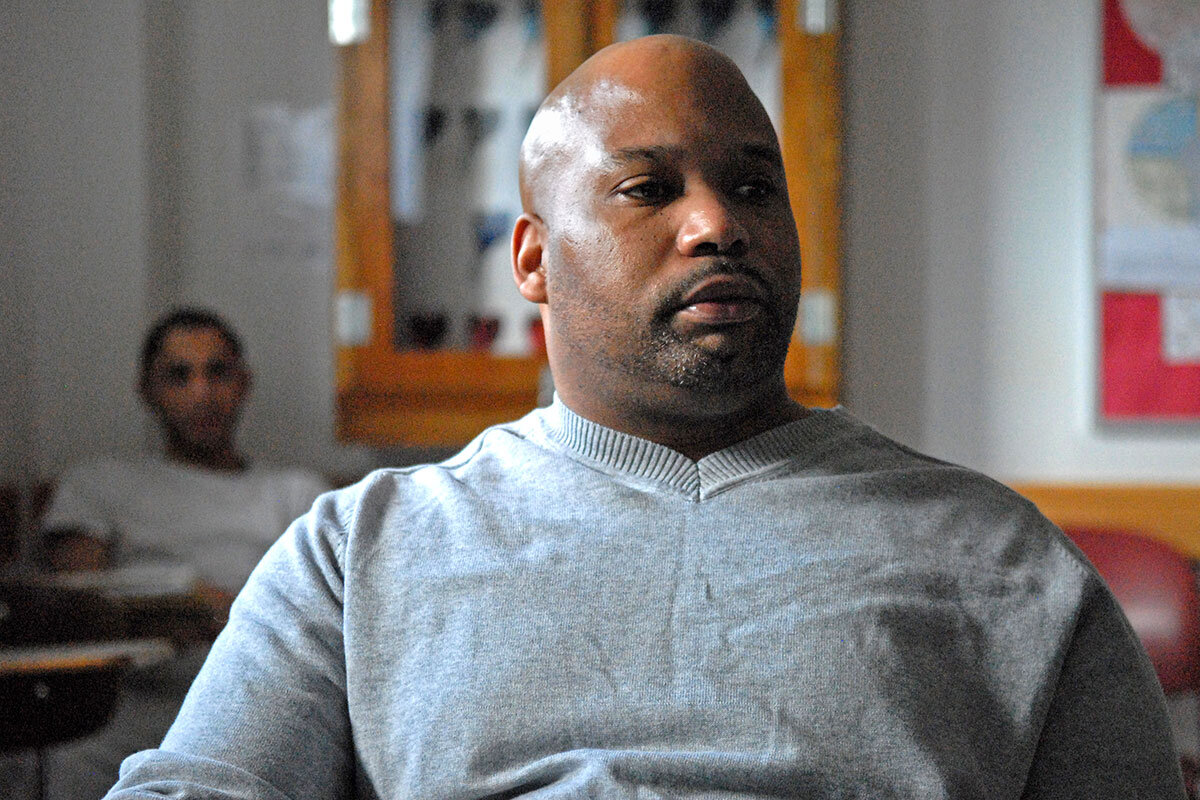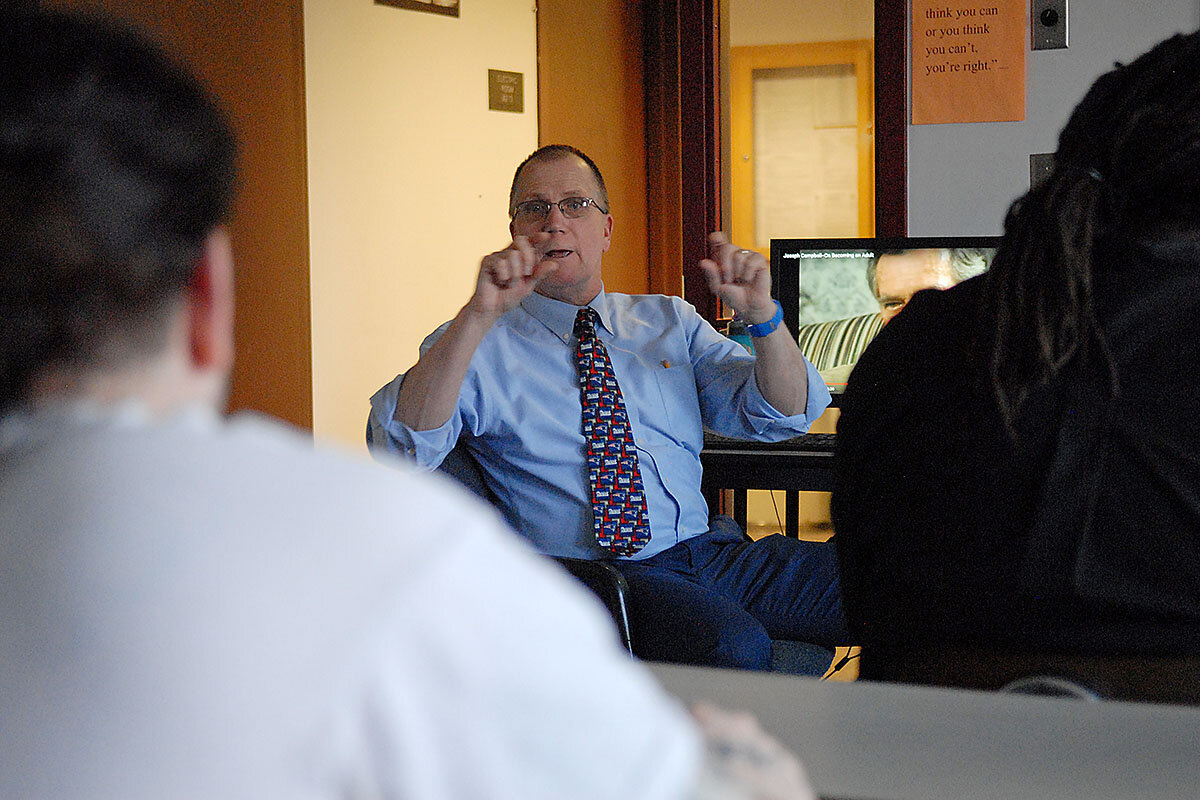A pressed gray suit, polished leather shoes, and a firm handshake. It isn’t difficult to peg Matthew Guillou as a working professional. But few would guess where he lived just six months ago.
In October, Mr. Guillou had just come out of jail for a two-year sentence for possession of narcotics. But he left prison with 21 credit hours from Roxbury Community College in Boston and a paid internship as a computer instructor for young people at STRIVE Boston, an organization that empowers community members by providing employment training. Guillou was soon promoted and is now a case manager.
Much of his job, Guillou says, is to help at-risk youth. “I teach them time management, I teach them Microsoft, and how to build resumes.” Then he pauses and laughs, “You know where I learned the skills?”
Guillou is referring to the training he received at the School of Reentry at the Boston Pre-Release Center, a first-of-its-kind program in Massachusetts. The men who designed and shepherd the entire operation – Ben Thompson, Edward McAdams, and Alan Spencer – are all passionate about criminal justice reform. They created the program to reduce recidivism and crime rates, but also saw it as an opportunity to use data about repeat offenders and education’s best practices to help inmates transition back into society.
“Many of these guys are so disadvantaged,” says Mr. Thompson, the Massachusetts assistant undersecretary of reentry. “What we’re saying to them is: You have value, you are college material, which is what they weren’t told [growing up].”
'An opportunity for real change'
The pilot program debuted in January 2016, and the most recent cohort started in September 2017. About 110 inmates applied in the latest round and 25 were selected, after being screened for serious offenses such as first- or second-degree murder. In the course of 12 to 18 months, student inmates receive training in three areas: HiSET, an exam that provides a high-school equivalency credential; vocational ed, which in this case means Microsoft software certification; and mindfulness.
“We are not reinventing the wheel, we are increasing the dosage,” says Thompson. “We know the correlation between education and crime, so all we’re trying to do is to give you more education. And the data confirms that it [education] will produce less crime.”
In Massachusetts, the most recent recidivism rate is 32 percent, and is typically calculated based on numbers collected two to three years post-release. While it is too soon to track data on the School of Reentry graduates, the program’s leaders note that 100 percent of the 2016 group are employed.
Education opens doors to jobs that have social and economic mobility, where people can feed their families, and begin lives that are contributing to their community and the economy, says Megan French-Marcelin, the Fair Hiring Project Coordinator with JustLeadershipUSA, a criminal justice reform advocacy group.
More discussion is needed around the best approach to educating people in the context of reentry, she says. While some efforts are successful, she suggests that the investment needs to come at the community level, long before incarceration happens.
“Access to education is critical,” Ms. French-Marcelin says. “We know the further along in education that people go, the less likely they are to recidivate.”
The public has a financial interest in that outcome as well. According to Thompson, data reveals that for every dollar taxpayers spend on inmates’ education, they get back $3 to $5 if inmates don’t reoffend – as opposed to paying thousands of dollars each year to keep them in jail.
“We really push with the guys to understand that if you change, it’s not just you that have changed: your kids have changed, your relationships have changed, your neighborhood starts to change,” says Mr. McAdams, the headmaster.
Research suggests that giving inmates an environment closer to a typical educational setting seems to be the key to a successful reentry program, he says.
In the School of Reentry, student inmates are immersed in their work from 8:30 a.m. to sometimes 6:30 p.m. They meet with faith groups and college tutors, attend Parents Helping Parents workshops, and receive counseling treatment from University of Massachusetts at Boston’s Addictions Counselor Education Program. The UMass program also provides training for student inmates who are interested in addiction counseling as a career path. After a day of classes and trainings, students return to their individual dorm rooms, which non-student inmates cannot access.
Kiminori Nakamura, an assistant professor of criminology and criminal justice at the University of Maryland in College Park, says a program with such intensity and a separate dorm room setting “is definitely not the norm.”
“The norm is the prison offers a couple classes,” says Mr. Nakamura. “The routine is maybe in the morning they [inmates] go to a drug treatment session, they go to lunch, they may have to do some work, then maybe in the afternoon there’s another GED class they have to attend. Then they go back to their cells and mingle with everyone else.”
Nakamura adds that programs that emphasize cognitive change for inmates, like this one, might yield better results in reducing recidivism.
Mindset shifts
Despite the intensive schedule, the school takes an unconventional approach to assessment. McAdams says he stays away from grading his students because they, by default, are used to failing. He adopts a “not yet" mindset – instead of assigning letter grades, he guides students with a focus on making progress. Even if they are “not yet” able to do something, they may eventually.
“When they first come in, they are totally deflated. ‘I’m not getting this; I’m stupid,’ ” McAdams says, describing the thoughts of his students, many of whom do not have high school diplomas. But after learning to switch their thinking path, “Now they say ‘I’m starting to get this,’ ” he says.
As for the vocational piece, Mr. Spencer, director of workforce development at the school, chose to provide Microsoft certificate training – which qualifies for college credit – to student inmates to boost their chances of acquiring better jobs.
“We are focusing on meaningful credentials,” says Spencer. “We want to change the picture of a guy leaving jail and [washing] dishes; we want to provide alternatives to that.”
Thompson adds, “The college credits give them incentive to continue education; they are not coming back [to prison] because we have given them the alternatives.”
Donald Haynesworth seems to share that vision. Having been in and out of the criminal system for more than 20 years, Mr. Haynesworth says he is ready to make this his last trip to prison. He began participating in the program in September and now has nine credit hours with Roxbury Community College. When asked how it feels to have college credits, Haynesworth shakes his head.
“There’s no feelings yet. It’s like a dream… I’m just going to keep on going,” he says. “When you get a certain amount of education, you want more. Because they say knowledge is power.”
Gratitude and a mission
Back at STRIVE, in Boston's Dorchester neighborhood, Guillou says he’s grateful.
“I am so fortunate that I’m placed here at this position and received the education I had,” he says. “If I didn’t have the education, where would I be? What type of housing would I be in? What kind of job would I get?”
He then lists a series of plans on his agenda. The next day, he’s starting a practicum to become a licensed drug and alcohol counselor. His sister is in the process to become licensed as well. Guillou plans to partner with her to open a practice one day. He says he likes giving back; he sees helping people as a form of service. What he is most proud of is that he’s a better father now.
“I see them every weekend now,” he says of his kids, noting that his relationship with them now is a lot better than he envisioned it would be. “They're so big now and college is around the corner. And trust me, they're going to college.”
Correction: This story has been updated to more accurately represent the full scope of Megan French-Marcelin's comments on education and reentry programs and to correct the precise wording of one of her quotes.








